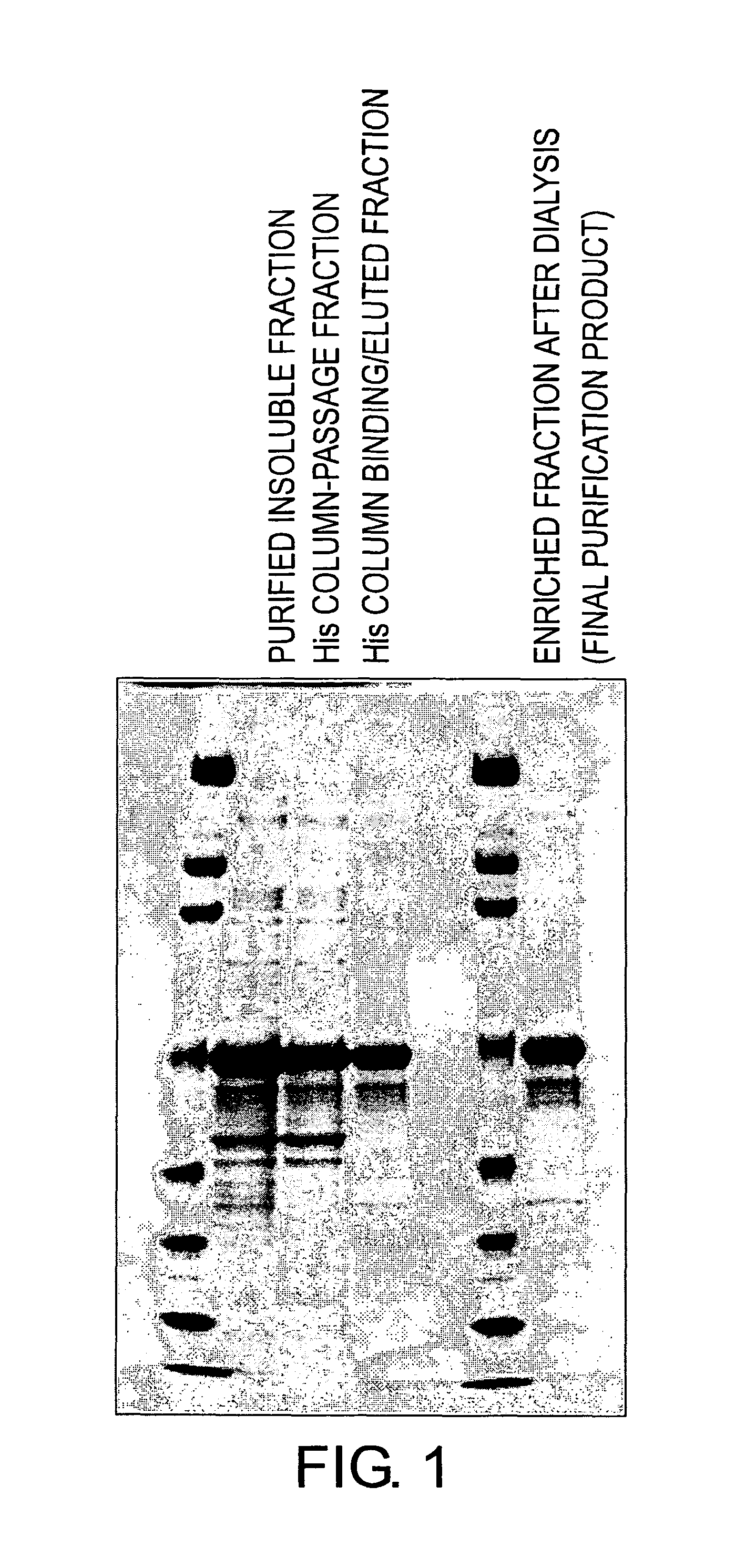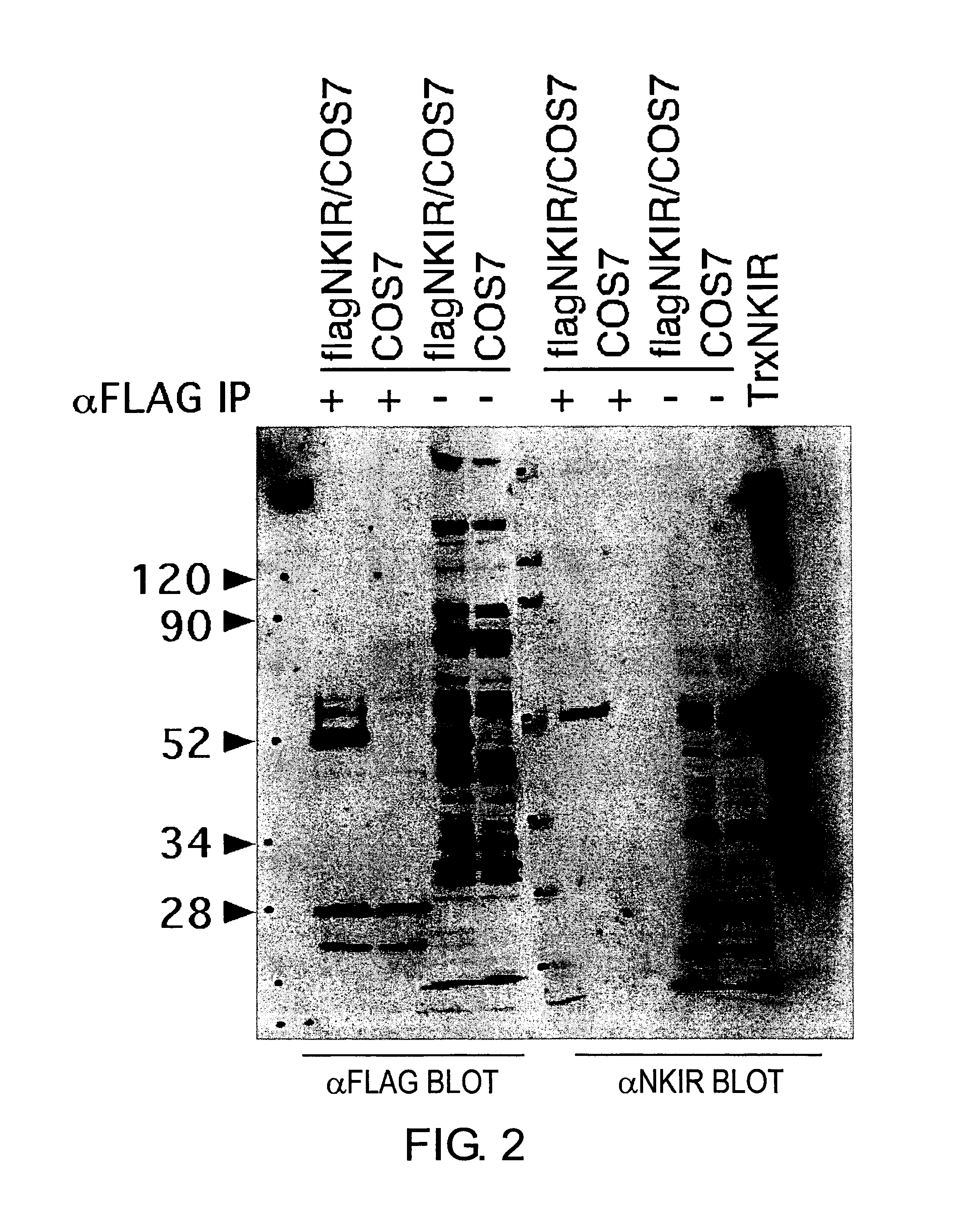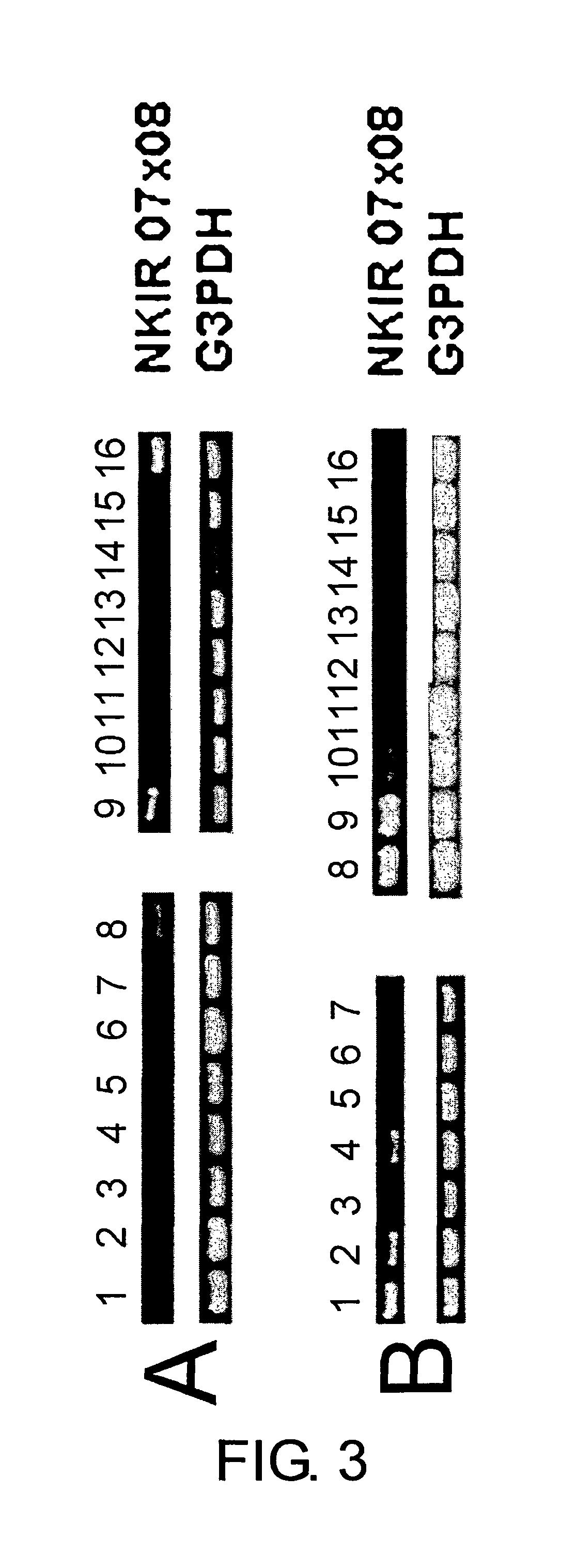Proteins expressed in NK cells
a technology of nk cells and proteins, applied in the field of new drugs, can solve the problems of malignant lymphoma-like pathological changes, death by pancytopenia, and inability to control viral infections, and achieve the effect of reducing the expression of mhc class i molecules
- Summary
- Abstract
- Description
- Claims
- Application Information
AI Technical Summary
Benefits of technology
Problems solved by technology
Method used
Image
Examples
example 1
Cloning of Full-Length Sequence
[0209]The present inventors found sequence tags for unidentified genes specific to NK cells (Table 1) among serial analysis of gene-expression (SAGE) data for immune cells disclosed at http: / / www.prevent.m.u-tokyo.ac.jp, and also discovered that the tags were present in the sequence AX191619 in the International publication (WO 0149728). Table 1 shows selective expression of the sequence tag (TGCCGCATAA) in an NK cell-derived library.
[0210]
TABLE 1Total numbersof analyzedTGCCGCATAAtagsPremature dendritic cells050795GM-CSF-induced macrophages050041LPS-stimulated monocytes030885Mature dendritic cells027602M-CSF-induced macrophages046833Monocytes051228Langerhans-like cells044873CD4 T cells (naive)041789CD4 T cells (memory, CCR4027733negative)CD4 T cells (memory, CCR4025415positive)Granulocytes023608Activated T cells (TH1)026498Activated T cells (TH2)025371NK cells629878
[0211]Primers SA1 (5′-TTGAATTCACACACCCACAGGACCTGCAGCTGAA-3′ / SEQ ID NO: 7), and SA2 (5′-T...
example 2
Detection of NKIR Protein Using Rabbit Polyclonal Antibody
[0260]An E. coli expression system was constructed, and a fusion protein comprising the NKIR extracellular domain was expressed and purified (FIG. 1). The procedure is described below in detail.
(1) Construction of E. coli Expression Plasmid pET32a-NK-sol for NKIR Fusion Protein
[0261]PCR was carried out under the following reaction conditions.[0262]Template: pGEMTE-NK1
[0263]
Primers:NKfusion (5′-CTCGGATCCTTGCCATCTTTAGTTCCCTGTGTT-3′ / SEQ ID NO: 26)NKr2 (5′-GCTGTCGACTTAGTTGCTGGCGGGAGTGAACAAGAC-3′ / SEQ ID NO: 27)
Reaction Conditions:[0264]94° C. for 2 minutes; and[0265]25 cycles of 94° C. for 20 seconds, 60° C. for 30 seconds, and 68° C. for 2 minutes.
[0266]PCR was carried out using KOD plus (TOYOBO; buffer, dNTPs, and MgSO4 were also supplied with the kit). After purification with MicroSpin S-300 HR column (Amersham Biosciences), the PCR product was digested with BamHI and SalI, and subjected to agarose gel electrophoresis. A band o...
example 3
Tissue Expression Analysis and Expression Analysis of NK Cell Lines
[0277]Tissue expression profiles were analyzed by PCR using the commercially available cDNA panel (Multiple Tissue cDNA (MTC) panel; Clontech Laboratories, Inc.) as a template.
[0278]PCR was carried out under the following reaction conditions.[0279]Template: MTC panel I, II, Human Immune System and Human Blood Fraction (Clontech Laboratories, Inc.)
[0280]
Primers:NKIR07 (5′-AGGTCAGAGTGCAGGCTCCTGTATC-3′ / SEQ ID NO: 30)NKIR08 (5′-TAGAACTGTCCTTTCTCCCCACGGT-3′ / SEQ ID NO: 31)
Reaction Conditions:[0281]94° C. for 30 seconds; and[0282]35 cycles of 94° C. for 30 seconds and 65° C. for 2 minutes.
[0283]PCR was carried out using TaKaRa Ex Taq (buffer and dNTP mixture were provided). The reaction volume was 50 μl. 5 μl of the reaction solution was electrophoresed in a 1% agarose gel. A 0.6 kb band was observed. G3PDH primers attached to the MTC panel were used in a control reaction.
[0284]The result showed that the gene was specifical...
PUM
 Login to View More
Login to View More Abstract
Description
Claims
Application Information
 Login to View More
Login to View More - R&D
- Intellectual Property
- Life Sciences
- Materials
- Tech Scout
- Unparalleled Data Quality
- Higher Quality Content
- 60% Fewer Hallucinations
Browse by: Latest US Patents, China's latest patents, Technical Efficacy Thesaurus, Application Domain, Technology Topic, Popular Technical Reports.
© 2025 PatSnap. All rights reserved.Legal|Privacy policy|Modern Slavery Act Transparency Statement|Sitemap|About US| Contact US: help@patsnap.com



